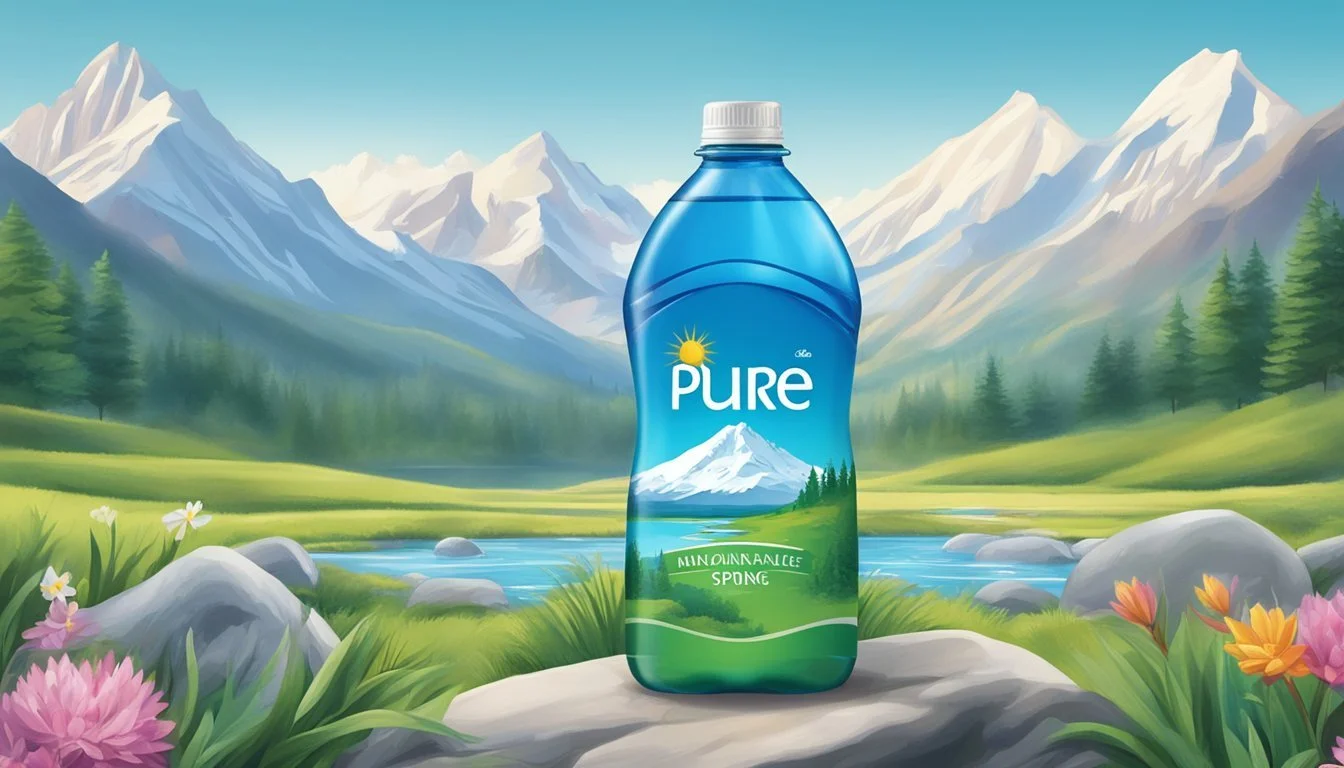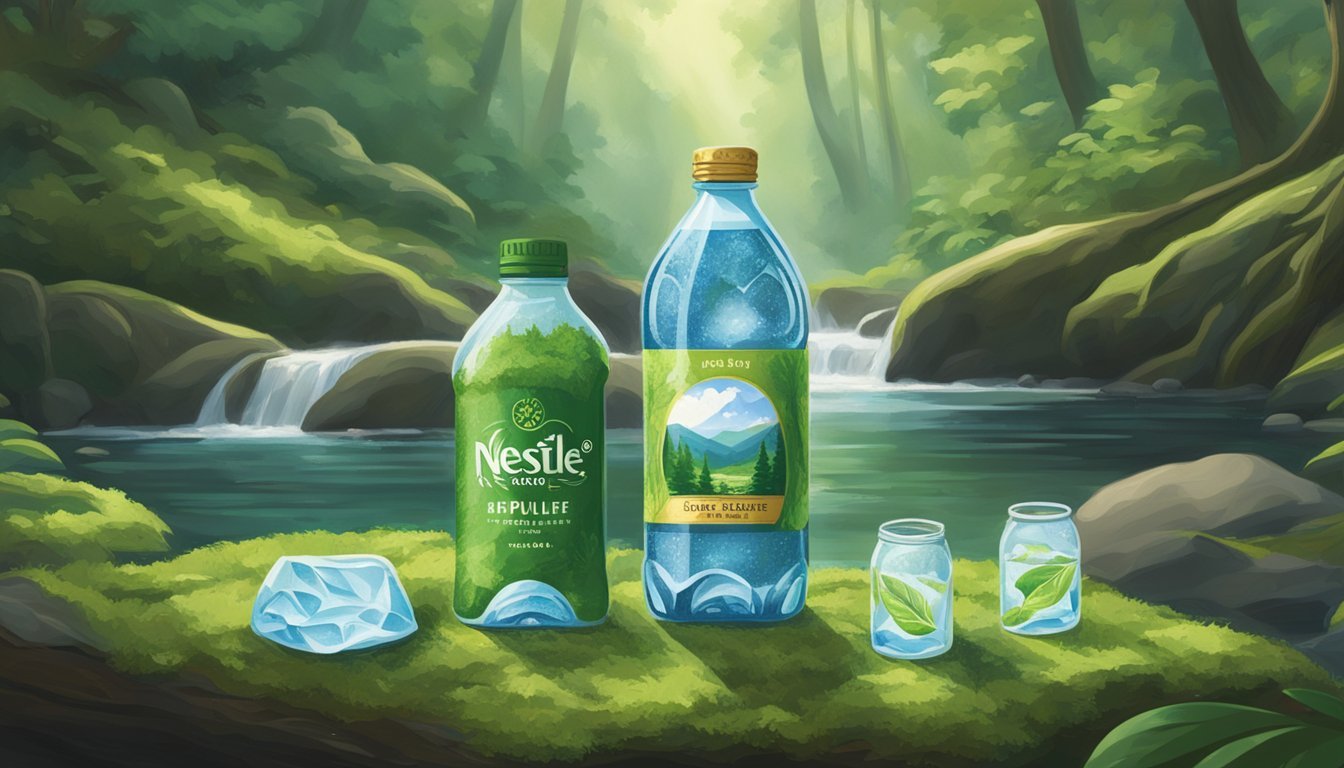Nestlé Pure Life vs. Ramona
Comparing Bottled Water Quality and Taste
Choosing the right bottled water can be challenging, especially with so many brands claiming superiority. Nestlé Pure Life and Ramona stand out in this crowded market. The debate isn't just about taste; it encompasses sourcing, processing techniques, and environmental impacts.
Nestlé Pure Life is one of the most recognized names in the bottled water industry. It offers a reliable and consistent taste, sourced from trusted wells and processed to ensure purification. On the other hand, Ramona is known for its natural spring water origins and minimal processing, aiming to keep the water's natural qualities intact.
For those prioritizing purity and a neutral taste, Nestlé Pure Life might be the go-to choice. Meanwhile, if the preference leans towards a more natural and minimally processed water, Ramona could be the better option. The final decision will hinge on individual priorities of taste, purity, and environmental considerations.
Overview of Bottled Water
Bottled water has become an essential product for many due to its convenience and assurance of clean drinking water. It is available in various forms and sizes, catering to different hydration needs.
Types of Bottled Water:
Spring Water: Drawn from natural springs.
Purified Water: Processed to remove impurities.
Mineral Water: Contains naturally occurring minerals.
Artesian Water: Comes from confined aquifers.
Benefits:
Convenience: Easy to carry and store.
Hydration: Ensures access to water anytime, aiding in maintaining hydration levels.
Safety: Often subjected to stringent filtration and quality control processes.
Popular Brands:
Nestlé Pure Life: Known for its purified water.
Ramona: Another choice for those seeking quality bottled water.
Considerations:
Environmental Impact: Plastic bottles contribute to waste.
Cost: Bottled water can be more expensive than tap water.
Packaging:
Plastic Bottles: Common but have environmental concerns.
Glass Bottles: Reusable, but heavier.
Boxed Water: Eco-friendly alternative gaining popularity.
The rise of bottled water reflects its role in providing reliable hydration and convenience in daily life. Different brands and types offer unique benefits, making it easy for consumers to find an option that meets their specific needs.
Background of the Brands
Nestlé Pure Life and Ramona each have distinct histories and qualities that set them apart. This section provides essential information about their origins, production processes, and brand positioning.
Nestlé Pure Life
Nestlé Pure Life is one of the most recognized bottled water brands globally. Launched by Nestlé in 1998, this brand emphasizes purity and accessibility. The water undergoes a multi-step filtration process, including reverse osmosis. This is done to remove impurities and ensure consistency in taste and quality.
Sourced from carefully selected wells and municipal supplies, Nestlé Pure Life is a purified water, rather than spring water. This allows for a controlled production environment. The brand is part of Nestlé Waters, which manages over 60 different water brands worldwide. The dedication to sustainability has led Nestlé Pure Life to focus on recyclable packaging and water conservation practices.
Ramona
Ramona, a lesser-known but emerging bottled water brand, has positioned itself as a premium option. Unlike Nestlé Pure Life, Ramona sources its water from natural springs. This source gives Ramona a unique mineral composition and taste, often appealing to those who prefer spring water over purified water.
The company emphasizes minimal processing to maintain the water's natural characteristics. Filtration is performed to remove contaminants while retaining essential minerals. Ramona is gaining traction for its commitment to environmental sustainability. This includes using eco-friendly packaging and supporting local water conservation efforts. Its focus on quality and natural sourcing has helped it carve out a niche in the competitive bottled water market.
Source and Origin of Water
Understanding where bottled water comes from helps consumers make informed choices. This section looks into the natural sources, such as springs and aquifers, and the purification processes involved in bottling water.
Natural Sources and Spring Water
Nestlé Pure Life sources its water from a mix of urban sources, springs, and wells. These sources are rigorously managed and monitored to ensure quality. Springs and aquifers are particularly valued as they naturally filter water through layers of rock and soil.
Ramona, on the other hand, heavily relies on natural spring water. The company prides itself on sourcing water from protected springs, which often have long-established reputations for purity. The springs are selected based on their mineral compositions and the quality of water.
The key difference between the two brands is that while Nestlé Pure Life uses a combination of municipal and natural sources, Ramona focuses on natural springs. This gives Ramona an edge for those who prefer water directly from natural springs.
Purified Water Processes
Nestlé Pure Life employs a multi-stage purification process. This includes reverse osmosis, which removes impurities, and additional filtration stages that ensure the water is safe and clean. Minerals are often reintroduced to enhance taste and provide a balanced mineral composition.
Ramona, focusing on natural spring water, undertakes fewer steps. The natural filtration through the earth's layers minimizes the need for extensive purification. Ramona's water primarily undergoes quality checks and minimal filtration to maintain its natural mineral content.
In contrast, Nestlé Pure Life's varying sources necessitate robust purification processes to ensure consistency regardless of the original water source. This includes thorough quality controls to ensure the water meets safety standards before reaching consumers. This makes Nestlé Pure Life suitable for those who prioritize purified water processes over natural sourcing.
Health and Quality Considerations
When evaluating Nestlé Pure Life and Ramona bottled water, it is essential to examine aspects related to mineral content, safety standards, and health benefits. These factors are crucial for determining the quality and safety of bottled water for consumers.
Mineral Content
Nestlé Pure Life adds a blend of minerals during its purification process, enhancing taste and supplementing essential nutrients like calcium and magnesium. Ramona, on the other hand, sources its water from natural springs, retaining native minerals which include potassium and sodium.
Mineral Content Comparison Table:
Brand Notable Minerals Source Type Nestlé Pure Life Calcium, Magnesium Purified with added minerals Ramona Potassium, Sodium Natural spring water
These differences in mineral composition impact not just flavor but also the nutritional benefits each brand offers.
Safety and Standards
Both brands adhere to strict safety standards to ensure water quality. Nestlé Pure Life utilizes a multiple-stage filtration process along with daily quality checks. This includes microfiltration, reverse osmosis, and ozonation to remove contaminants.
Ramona maintains similar high standards by sourcing from protected springs and implementing rigorous quality control measures. Regular testing confirms the absence of harmful contaminants such as lead and arsenic.
Key Points:
Nestlé Pure Life: Multiple-stage filtration, daily quality checks
Ramona: Sourced from protected springs, stringent quality controls
These methods ensure both brands provide safe, contaminant-free drinking water.
Health Benefits
The health benefits of bottled water often depend on mineral content and purity. Nestlé Pure Life's added minerals can support bone health and metabolic functions. Calcium and magnesium, for instance, contribute to maintaining healthy bones and cardiovascular systems.
Ramona’s naturally occurring minerals offer similar benefits, promoting hydration and electrolyte balance. The natural composition can also aid in better hydration efficiency compared to demineralized water options.
Differences in mineral composition and purity measures are essential for selecting the water best suited to individual health needs. Both brands prioritize delivering quality and safe drinking water to consumers.
Taste and Consumer Preference
Consumers often focus on the taste, the presence of minerals, and how refreshing the water is when choosing between Nestlé Pure Life and Ramona.
Taste: Many consumers find Nestlé Pure Life to have a clean and crisp taste. It's purified water, which removes impurities, providing a neutral flavor that appeals to those who prefer a straightforward drinking experience.
Ramona, on the other hand, is often described as having a more mineral-rich taste. This can be refreshing for some, providing a slight hint of natural minerals that can enhance the mouthfeel and overall drinking experience.
Minerals: Nestlé Pure Life undergoes a purification process that ensures a clean taste but results in fewer natural minerals. For those who prefer their water with minimal mineral presence, this is a favorable choice.
Ramona contains a higher level of natural minerals, offering a more robust taste profile. This can be appealing for people looking for water that feels more natural and possibly more refreshing due to its mineral content.
Consumer Preference: Preference often splits based on individual taste and expectations. Consumers who enjoy a neutral, no-frills drinking experience tend to lean towards Nestlé Pure Life. Its purified nature ensures no aftertaste or unusual flavors.
For those who seek a unique taste enriched by minerals, Ramona frequently becomes the preferred option. It offers a sense of natural purity and a refreshing feel that makes it stand out among other bottled waters.
Environmental and Sustainability Practices
Nestlé Pure Life and Ramona differ in their approaches to environmental sustainability. This section covers their packaging choices and overall environmental impact.
Packaging and Bottles
Nestlé Pure Life uses PET plastic bottles, known for their durability and recyclability. They are working to increase the use of recycled plastics in their bottles to address environmental concerns.
Ramona opts for lighter, eco-friendly packaging. Many of their products use recyclable materials, minimizing waste. The focus on sustainable packaging helps reduce their overall environmental footprint. Both companies are addressing plastic waste issues through various recycling initiatives.
Environmental Impact
Nestlé Pure Life focuses on reducing water usage in their bottling process by requiring less than 2.5 liters of water to produce one liter of product. They collaborate with NGOs and public authorities to promote recycling and sustainable practices.
Ramona emphasizes locally sourced water to reduce transportation emissions. Their operations highlight eco-friendly harvesting methods to conserve natural resources. Both brands are taking significant steps to mitigate their environmental impact and promote sustainability within the industry.
Accessibility and Availability
Nestlé Pure Life is widely accessible, making it a convenient choice for many consumers. It's available throughout the United States and in numerous international markets. This extensive reach ensures that most people can easily find this brand in local stores and online.
In contrast, Ramona water caters to a more regional market. Availability may be limited to specific areas, which can restrict access for some consumers. This regional focus might be appealing to those who prefer locally sourced products but less convenient for others seeking broader accessibility.
Accessibility Comparison:
Brand Availability Market Reach Nestlé Pure Life Nationwide & International Broad accessibility Ramona Regional Limited accessibility
Both brands offer affordability, meeting the needs of budget-conscious consumers. However, the wide distribution network of Nestlé Pure Life often makes it the more readily available option when compared to Ramona's more localized distribution.
In terms of convenience, Nestlé Pure Life's extensive distribution network provides an advantage, allowing easy purchase in numerous locations. Ramona's regional focus, while offering a unique market proposition, may require more effort to locate, particularly outside its primary distribution areas.
Brand Comparisons and Alternatives
When choosing between bottled water brands like Nestlé Pure Life and Ramona, it's important to consider their unique qualities, pricing, and how they stack up against other popular brands. This can help consumers make informed decisions based on their preferences and needs.
Comparison with Other Major Brands
Nestlé Pure Life is known for providing quality hydration at a reasonable cost, often sold in larger quantities to reduce the cost per bottle. It faces competition from brands like Dasani and Aquafina, both of which are owned by major beverage companies and offer purified water with added minerals for taste.
Fiji Water is marketed as a premium product, sourced from an artesian aquifer in Fiji. It is often more expensive but praised for its natural filtration process. Voss offers similar premium positioning, known for its minimalist design and purity, originating from Norway.
Ozarka, sourced locally in Texas, and Poland Spring, sourced from Maine, cater primarily to regional markets but share Nestlé's commitment to natural spring water sources. These regional brands often have loyal followings due to the perceived freshness and local sourcing of the water.
San Pellegrino and Perrier are sparkling water alternatives, providing a different taste experience and often used in culinary settings. They highlight the variety available in bottled water markets for different consumer needs.
Considerations for Consumers
Consumers should consider several factors when choosing bottled water. The source of the water, such as natural springs versus purified tap water, can impact both taste and perceived quality. Electrolytes added for taste can appeal to those interested in enhanced hydration properties.
Pricing is another critical factor. While brands like Nestlé Pure Life offer affordable options in bulk, premium brands like Fiji and Voss come with higher price tags due to their exotic sources and branding.
Whether the water is still or sparkling can influence preference, with brands like San Pellegrino and Perrier catering to those who enjoy carbonation. Additionally, bottling practices and sustainability efforts, such as those by Boxed Water, may sway environmentally conscious consumers.
Those seeking specific health benefits might gravitate towards brands with unique properties, like Icelandic Glacial with its alkaline nature or Eternal Water which boasts naturally occurring electrolytes. Each brand's unique selling point should align with consumer priorities, whether it's cost, taste, source, or added health benefits.
Conclusion and Recommendations
Nestlé Pure Life is known for its neutral and balanced taste, which many consumers find appealing. This brand employs multiple-stage filtration and quality checks, ensuring a reliable product. Ramona, on the other hand, highlights a more local sourcing approach and boasts a unique, slightly mineral taste.
Bottom Line:
Nestlé Pure Life: Consistent quality, widely recognized, extensive filtration.
Ramona: Emphasis on local quality, distinct mineral flavor.
Tips for Choosing:
If a neutral flavor is preferred, Nestlé Pure Life is a solid choice.
For those who appreciate a taste with character, Ramona may be more suitable.
Signal your preference by considering factors such as taste, sourcing, and filtration. Both brands have strong points that cater to different tastes and priorities.
Evaluating these options through email surveys or marketing signals can provide insights into customer preferences.
Ultimately, either brand can cater to the diverse needs of bottled water consumers, but understanding individual taste preferences and priorities will help decide which one is the better fit.
More About Nestlé Pure Life
Acqua Panna vs Nestle Pure Life: Which Bottled Water is Better?
Aquafina vs Nestle Pure Life: Which Bottled Water is Better?
Arrowhead vs Nestle Pure Life: Which Bottled Water is Better?
Boxed Water vs Nestle Pure Life: Which Bottled Water is Better?
Core Hydration vs Nestle Pure Life: Which Bottled Water is Better?
Deer Park vs Nestle Pure Life: Which Bottled Water is Better?
Essentia vs Nestle Pure Life: Which Bottled Water is Better?
Ice Mountain vs Nestle Pure Life: Which Bottled Water is Better?
Icelandic Glacial vs Nestle Pure Life: Which Bottled Water is Better?
Just Water vs Nestle Pure Life: Which Bottled Water is Better?
Mountain Valley Spring Water vs Nestle Pure Life: Which Bottled Water is Better?
Nestle Pure Life vs 1907water: Which Bottled Water is Better?
Nestle Pure Life vs 7-Select: Which Bottled Water is Better?
Nestle Pure Life vs Alkaline88: Which Bottled Water is Better?
Nestle Pure Life vs Antipodes: Which Bottled Water is Better?
Nestle Pure Life vs Aqua Carpatica: Which Bottled Water is Better?
Nestle Pure Life vs Big Chill: Which Bottled Water is Better?
Nestle Pure Life vs BodyArmor: Which Bottled Water is Better?
Nestle Pure Life vs Cascade Mountain: Which Bottled Water is Better?
Nestle Pure Life vs Castle Rock: Which Bottled Water is Better?
Nestle Pure Life vs CBD Living: Which Bottled Water is Better?
Nestle Pure Life vs Crystal Geyser: Which Bottled Water is Better?
Nestle Pure Life vs Crystal Lake: Which Bottled Water is Better?
Nestle Pure Life vs Essence pH10: Which Bottled Water is Better?
Nestle Pure Life vs Hawaii Volcanic: Which Bottled Water is Better?
Nestle Pure Life vs Hawaiian Springs: Which Bottled Water is Better?
Nestle Pure Life vs Kirkland Signature: Which Bottled Water is Better?
Nestle Pure Life vs Liquid Death: Which Bottled Water is Better?
Nestle Pure Life vs Mananalu: Which Bottled Water is Better?
Nestle Pure Life vs Open Water: Which Bottled Water is Better?
Nestle Pure Life vs Poland Spring: Which Bottled Water is Better?
Nestle Pure Life vs Proud Source: Which Bottled Water is Better?
Nestle Pure Life vs Pure Life: Which Bottled Water is Better?
Nestle Pure Life vs Purely Sedona: Which Bottled Water is Better?
Nestle Pure Life vs Refreshe: Which Bottled Water is Better?
Nestle Pure Life vs Richard's Rainwater: Which Bottled Water is Better?
Nestle Pure Life vs San Pellegrino: Which Bottled Water is Better?
Nestle Pure Life vs Simple Truth: Which Bottled Water is Better?
Nestle Pure Life vs Smartwater: Which Bottled Water is Better?
Nestle Pure Life vs Solan de Cabras: Which Bottled Water is Better?
Nestle Pure Life vs Talking Rain AQA: Which Bottled Water is Better?
Nestle Pure Life vs The Well: Which Bottled Water is Better?
Nestle Pure Life vs Topo Chico: Which Bottled Water is Better?
Nestle Pure Life vs Tru Alka: Which Bottled Water is Better?
Nestle Pure Life vs Weird Water: Which Bottled Water is Better?
Nestle Pure Life vs Whole Foods 365: Which Bottled Water is Better?
Nestle Pure Life vs Whole Foods Italian Still Mineral water: Which Bottled Water is Better?
Nestle Pure Life vs Zephyrhills: Which Bottled Water is Better?










